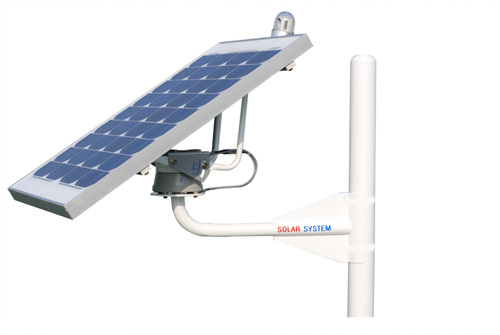Solar Tracker System
A solar tracker is a device that orients a payload toward the sun. Payloads can be photovoltaic panels, reflectors, lenses or other optical devices.
In flat-panel photovoltaic (PV) applications, trackers are used to minimize the angle of incidence between the incoming sunlight and a photovoltaic panel. This increases the amount of energy produced from a fixed amount of installed power generating capacity. In standard photovoltaic applications, it is estimated that trackers are used in at least 85% of commercial installations greater than 1MW from 2009 to 2012.
n concentrated photovoltaic (CPV) and concentrated solar thermal (CSP) applications, trackers are used to enable the optical components in the CPV and CSP systems. The optics in concentrated solar applications accept the direct component of sunlight light and therefore must be oriented appropriately to collect energy. Tracking systems are found in all concentrator applications because such systems do not produce energy unless pointed at the sun.
Basic concept
Sunlight has two components, the “direct beam” that carries about 90% of the solar energy, and the “diffuse sunlight” that carries the remainder – the diffuse portion is the blue sky on a clear day and increases proportionately on cloudy days. As the majority of the energy is in the direct beam, maximizing collection requires the sun to be visible to the panels as long as possible.
The energy contributed by the direct beam drops off with the cosine of the angle between the incoming light and the panel.
Types of solar collector
Different types of solar collector and their location (latitude) require different types of tracking mechanism. Solar collectors may be:
non-concentrating flat-panels, usually photovoltaic or hot-water.
concentrating systems, of a variety of types.
Design of the Proposed Solar Tracking System
The proposed solar tracking system should satisfy certain technical requirements specific to the studied application, as follows:
- minimum energy consumption, for the maximization of global efficiency of the installation and optimum performance-cost ratio;
- reliability in operation, under different perturbation conditions (wind, dust, rain, important temperature variations);
- simplicity of movement solution (motor, gears, sensors), to diminish the cost and to increase the viability;
- possibility of system integration in a monitoring and control centralized structure, which means a digital control solution.
Taking into account these implicitly necessary technical requirements, the chosen solution to drive the PV panel is based on the following components:
- A DC electric motor, voltage mode driven, with current monitoring, without movement sensors (speed or position);
- A motor control system of intelligent drive type, completely digital, that allows the implementation of the digital control of the motor as well as the implementation in a dedicated motion control language of the PV panel orientation application;
- A measurement system for light intensity applied to the PV panel, representing the sensor that commands the solar panel movement.
The chosen technical solution offers the following important advantages:
- simplicity of power scheme: DC motor and H bridge converter (4 transistors) for the motor drive;
- use of a compact drive equipment, with a high degree of integration and intelligence, that incorporates in a single module both the power converter and its command system, motion command unit (motion controller), and specific automation elements (of PLC type);
- use of an innovative solution, simple and reliable for the measurement system of light signal intensity.




